Influence of Inlets Morphology and Forcing Mechanisms on Water Exchange between Coastal Basins and the Sea: A Hindcast Study for a Mediterranean Lagoon
Abstract
1. Introduction
2. Materials and Methods
2.1. Framework of the Study Area
2.2. The Numerical Model
2.3. Indexes of Water Transport Timescale and Water Renewal
3. Validation and Calibration of the Numerical Model
4. Historical Scenarios Selected for the Hindcast
5. Results
5.1. Analysis of the Present Scenario
5.2. Comparative Analysis of the Selected Hindcast Scenarios
6. Discussion
7. Conclusions
Author Contributions
Funding
Institutional Review Board Statement
Informed Consent Statement
Data Availability Statement
Acknowledgments
Conflicts of Interest
References
- Umgiesser, G.; Zemlys, P.; Erturk, A.; Razinkova-Baziukas, A.; Mėžinė, J.; Ferrarin, C. Seasonal renewal time variability in the Curonian Lagoon caused by atmospheric and hydrographical forcing. Ocean Sci. 2016, 12, 391–402. [Google Scholar] [CrossRef]
- Kennish, M.J.; Paerl, H.W. (Eds.) Coastal Lagoons: Critical Habitats of Environmental Change; Marine Science Series; Taylor & Francis: Boca Raton, FL, USA, 2010; ISBN 978-1-4200-8830-4. [Google Scholar]
- Lillebø, A.I.; Stålnacke, P.; Gooch, G.D.; Krysanova, V.; Bielecka, M. Pan-European management of coastal lagoons: A science-policy-stakeholder interface perspective. Estuar. Coast. Shelf Sci. 2017, 198, 648–656. [Google Scholar] [CrossRef]
- Deb, S.; Guyondet, T.; Coffin, M.R.S.; Barrell, J.; Comeau, L.A.; Clements, J.C. Effect of inlet morphodynamics on estuarine circulation and implications for sustainable oyster aquaculture. Estuar. Coast. Shelf Sci. 2022, 269, 107816. [Google Scholar] [CrossRef]
- Sinha, E.; Michalak, A.M.; Balaji, V. Eutrophication will increase during the 21st century as a result of precipitation changes. Science 2017, 357, 405–408. [Google Scholar] [CrossRef]
- Defne, Z.; Ganju, N.K. Quantifying the Residence Time and Flushing Characteristics of a Shallow, Back-Barrier Estuary: Application of Hydrodynamic and Particle Tracking Models. Estuar. Coasts 2015, 38, 1719–1734. [Google Scholar] [CrossRef]
- Coffin, M.R.S.; Courtenay, S.C.; Pater, C.C.; van den Heuvel, M.R. An empirical model using dissolved oxygen as an indicator for eutrophication at a regional scale. Mar. Pollut. Bull. 2018, 133, 261–270. [Google Scholar] [CrossRef]
- Clunies, G.J.; Mulligan, R.P.; Mallinson, D.J.; Walsh, J.P. Modeling hydrodynamics of large lagoons: Insights from the Albemarle-Pamlico Estuarine System. Estuar. Coast. Shelf Sci. 2017, 189, 90–103. [Google Scholar] [CrossRef]
- Mallinson, D.J.; Smith, C.W.; Culver, S.J.; Riggs, S.R.; Ames, D. Geological characteristics and spatial distribution of paleo-inlet channels beneath the outer banks barrier islands, North Carolina, USA. Estuar. Coast. Shelf Sci. 2010, 88, 175–189. [Google Scholar] [CrossRef]
- Luettich, R.A.; Carr, S.D.; Reynolds-Fleming, J.V.; Fulcher, C.W.; McNinch, J.E. Semi-diurnal seiching in a shallow, micro-tidal lagoonal estuary. Cont. Shelf Res. 2002, 22, 1669–1681. [Google Scholar] [CrossRef]
- Panda, U.S.; Mohanty, P.K.; Samal, R.N. Impact of tidal inlet and its geomorphological changes on lagoon environment: A numerical model study. Estuar. Coast. Shelf Sci. 2013, 116, 29–40. [Google Scholar] [CrossRef]
- Ferrarin, C.; Ghezzo, M.; Umgiesser, G.; Tagliapietra, D.; Camatti, E.; Zaggia, L.; Sarretta, A. Assessing hydrological effects of human interventions on coastal systems: Numerical applications to the Venice Lagoon. Hydrol. Earth Syst. Sci. 2013, 17, 1733–1748. [Google Scholar] [CrossRef]
- Obolewski, K.; Glińska-Lewczuk, K.; Astel, A. Lost connectivity between a coastal lagoon and the sea—Implications of floodgate closure for benthic macroinvertebrates. Estuar. Coast. Shelf Sci. 2018, 211, 77–89. [Google Scholar] [CrossRef]
- Lenzi, M.; Renzi, M.; Nesti, U.; Gennaro, P.; Persia, E.; Porrello, S. Vegetation cyclic shift in eutrophic lagoon. Assessment of dystrophic risk indices based on standing crop evaluations. Estuar. Coast. Shelf Sci. 2013, 132, 99–107. [Google Scholar] [CrossRef]
- Migliore, G.; Alisi, C.; Sprocati, A.R.; Massi, E.; Ciccoli, R.; Lenzi, M.; Wang, A.; Cremisini, C. Anaerobic digestion of macroalgal biomass and sediments sourced from the Orbetello lagoon, Italy. Biomass Bioenergy 2012, 42, 69–77. [Google Scholar] [CrossRef]
- Lenzi, M.; Persiano, M.; Gennaro, P.; Rubegni, F. Wind Mitigating Action on Effects of Eutrophication in Coastal Eutrophic Water Bodies. IJMO 2016, 3, 14–20. [Google Scholar] [CrossRef]
- Cappietti, L.; Scroccaro, I. The hydrodynamics of the Orbetello Lagoon. Measurements and numerical simulations. In Proceedings of the 29° Convegno di Idraulica e Costruzioni Idrauliche, Trento, Italy, 7–10 September 2004; pp. 613–618. [Google Scholar]
- Lenzi, M.; Palmieri, R.; Porrello, S. Restoration of the eutrophic Orbetello lagoon (Tyrrhenian Sea, Italy): Water quality management. Mar. Pollut. Bull. 2003, 46, 1540–1548. [Google Scholar] [CrossRef]
- Renzi, M.; Guerranti, C. Seasonal Fluctuations of Trace Elements from Different Habitats of Orbetello Lagoon (Thyrrenian Sea, Italy). Arch. Environ. Contam. Toxicol. 2018, 74, 92–113. [Google Scholar] [CrossRef] [PubMed]
- Tomassetti, P.; Lenzi, M.; Lattanzi, L.; Persia, E.; Mercatali, I.; Gennaro, P.; Vani, D.; Porrello, S. Modifications of macrobenthos assemblages on land–based fish farm phytotreatment basins in the Orbetello lagoon. Int. J. Environ. Health 2015, 7, 114–127. [Google Scholar] [CrossRef]
- Miniero, R.; Beccaloni, E.; Carere, M.; Ubaldi, A.; Mancini, L.; Marchegiani, S.; Cicero, M.R.; Scenati, R.; Lucchetti, D.; Ziemacki, G.; et al. Mercury (Hg) and methyl mercury (MeHg) concentrations in fish from the coastal lagoon of Orbetello, central Italy. Mar. Pollut. Bull. 2013, 76, 365–369. [Google Scholar] [CrossRef]
- Borghini, F.; Lucattini, L.; Focardi, S.; Focardi, S.; Bastianoni, S. Production of bio-diesel from macro-algae of the Orbetello lagoon by various extraction methods. Int. J. Sustain. Energy 2014, 33, 695–703. [Google Scholar] [CrossRef]
- Lenzi, M.; Salvaterra, G.; Gennaro, P.; Mercatali, I.; Persia, E.; Porrello, S.; Sorce, C. A new approach to macroalgal bloom control in eutrophic, shallow-water, coastal areas. J. Environ. Manag. 2015, 150, 456–465. [Google Scholar] [CrossRef] [PubMed]
- Lenzi, M.; Gennaro, P.; Mercatali, I.; Persia, E.; Solari, D.; Porrello, S. Physico-chemical and nutrient variable stratifications in the water column and in macroalgal thalli as a result of high biomass mats in a non-tidal shallow-water lagoon. Mar. Pollut. Bull. 2013, 75, 98–104. [Google Scholar] [CrossRef] [PubMed]
- Lenzi, M.; Leporatti-Persiano, M.; Gennaro, P. C, N, P, S content of the Chlorophyta Chaetomorpha linum (Müller) Kützing in a vast high density mat of a Mediterranean non-tidal lagoon. Knowl. Manag. Aquat. Ecosyst. 2020, 38, 421. [Google Scholar] [CrossRef]
- Cappietti, L.; Crema, I.; Simonetti, I. Assessing water exchange between sea and the Orbetello lagoon (Italy) by field measurements and numerical simulations. In Proceedings of the 2018 IEEE International Workshop on Metrology for the Sea, Learning to Measure Sea Health Parameters (MetroSea), Bari, Italy, 8–10 October 2018; pp. 55–59. [Google Scholar]
- Bombelli, V.; Lenzi, M. Italy—The Orbetello Lagoon and the Tuscan Coast. In Marine Benthic Vegetation Recent Changes and the Effects of Eutrophication; Ecological Studies; Springer: Berlin/Heidelberg, Germany, 1996; Volume 123, pp. 331–337. [Google Scholar] [CrossRef]
- Giovani, A.; Mari, E.; Specchiulli, A.; Focardi, S.E.; Renzi, M. Recent changes in macroalgae distribution patterns in the Orbetello lagoon (Italy). Transit. Waters Bull. 2014, 8, 10–23. [Google Scholar] [CrossRef]
- Ludovico, A. La Laguna di Orbetello, Studi, Ricerche, Criteri e Modalità di Intervento in Quattro Anni di Gestione Commissariale 2003–2006; Graffietti Stampati: Montefiascone, Italy, 2006. [Google Scholar]
- Lenzi, M.; Franchi, E.; Leporatti-Persiano, M.; D’Agostino, A.; Gennaro, P.; Marsili, L. Assessment of the causes of Hg bioaccumulation in the fish of a Mediterranean lagoon subject to environmental management interventions. Mar. Pollut. Bull. 2021, 162, 111907. [Google Scholar] [CrossRef]
- Lenzi, M. Artificial top layer sediment resuspension to counteract Chaetomorpha linum (Muller) Kutz blooms in a eutrophic lagoon. Three years full-scale experience. JAMB 2017, 5, 00114. [Google Scholar] [CrossRef]
- DHI. MIKE 21 Flow Model & MIKE 21 Flood Screening Tool—Hydrodynamic Module; DHI Headquarters: Hørsholm, Denmark, 2017; p. 58. Available online: https://manuals.mikepoweredbydhi.help/2017/Coast_and_Sea/M21HDFST_Scientific_Doc.pdf (accessed on 1 March 2022).
- Roe, P.L. Approximate Riemann solvers, parameter vectors, and difference schemes. J. Comput. Phys. 1981, 43, 357–372. [Google Scholar] [CrossRef]
- Clementi, E.; Aydogdu, A.; Goglio, A.C.; Pistoia, J.; Escudier, R.; Drudi, M.; Grandi, A.; Mariani, A.; Lyubartsev, V.; Lecci, R.; et al. Mediterranean Sea Physical Analysis and Forecast (CMEMS MED-Currents, EAS6 System): MEDSEA_ANALYSISFORECAST_PHY_006_013; Copernicus Monitoring Environment Marine Service (CMEMS): Bologna, Italy, 2021. [Google Scholar] [CrossRef]
- Cheng, Y.; Baltazar Andersen, O. Improvement in Global Ocean Tide Model in Shallow Water Regions. 2010. Available online: https://www.space.dtu.dk/English/Research/Scientific_data_and_models/Global_Ocean_Tide_Model.aspx (accessed on 1 March 2022).
- Tapia González, F.U.; Herrera-Silveira, J.A.; Aguirre-Macedo, M.L. Water quality variability and eutrophic trends in karstic tropical coastal lagoons of the Yucatán Peninsula. Estuar. Coast. Shelf Sci. 2008, 76, 418–430. [Google Scholar] [CrossRef]
- Takeoka, H. Fundamental concepts of exchange and transport time scales in a coastal sea. Cont. Shelf Res. 1984, 3, 311–326. [Google Scholar] [CrossRef]
- Cucco, A.; Umgiesser, G. Modeling the Venice Lagoon residence time. Ecol. Model. 2006, 193, 34–51. [Google Scholar] [CrossRef]
- Abouelsaad, O.; Matta, E.; Hinkelmann, R. Hydrodynamic response of artificial lagoons considering tide, wind and tracer—Case study El Gouna, Egypt. Reg. Stud. Mar. Sci. 2022, 52, 102290. [Google Scholar] [CrossRef]
- Marsooli, R.; Orton, P.; Fitzpatrick, J.; Smith, H. Residence Time of a Highly Urbanized Estuary: Jamaica Bay, New York. J. Mar. Sci. Eng. 2018, 6, 44. [Google Scholar] [CrossRef]
- Monsen, N.E.; Cloern, J.E.; Lucas, L.V.; Monismith, S.G. A comment on the use of flushing time, residence time, and age as transport time scales. Limnol. Oceanogr. 2002, 47, 1545–1553. [Google Scholar] [CrossRef]
- Umgiesser, G.; Ferrarin, C.; Cucco, A.; De Pascalis, F.; Bellafiore, D.; Ghezzo, M.; Bajo, M. Comparative hydrodynamics of 10 Mediterranean lagoons by means of numerical modeling. J. Geophys. Res. Ocean. 2014, 119, 2212–2226. [Google Scholar] [CrossRef]
- García-Oliva, M.; Pérez-Ruzafa, Á.; Umgiesser, G.; McKiver, W.; Ghezzo, M.; De Pascalis, F.; Marcos, C. Assessing the Hydrodynamic Response of the Mar Menor Lagoon to Dredging Inlets Interventions through Numerical Modelling. Water 2018, 10, 959. [Google Scholar] [CrossRef]
- Elyaagoubi, S.; Umgiesser, G.; Maanan, M.; Maicu, F.; Mėžinė, J.; Hilmi, K.; Razinkovas-Baziukas, A. Effects of Groundwater Inputs to the Hydraulic Circulation, Water Residence Time, and Salinity in a Moroccan Atlantic Lagoon. J. Mar. Sci. Eng. 2022, 10, 69. [Google Scholar] [CrossRef]
- Mendes, J.; Ruela, R.; Picado, A.; Pinheiro, J.P.; Ribeiro, A.S.; Pereira, H.; Dias, J.M. Modeling Dynamic Processes of Mondego Estuary and Óbidos Lagoon Using Delft3D. J. Mar. Sci. Eng. 2021, 9, 91. [Google Scholar] [CrossRef]
- Filgueira, R.; Guyondet, T.; Comeau, L.A.; Tremblay, R. Bivalve aquaculture-environment interactions in the context of climate change. Glob. Chang. Biol. 2016, 22, 3901–3913. [Google Scholar] [CrossRef]
- Zoidou, M.; Kokkos, N.; Sylaios, G. Dynamics of Water, Salt, and Nutrients Exchange at the Inlets of Three Coastal Lagoons. J. Mar. Sci. Eng. 2022, 10, 205. [Google Scholar] [CrossRef]
- Soria, J.; Vera-Herrera, L.; Calvo, S.; Romo, S.; Vicente, E.; Sahuquillo, M.; Sòria-Perpinyà, X. Residence Time Analysis in the Albufera of Valencia, a Mediterranean Coastal Lagoon, Spain. Hydrology 2021, 8, 37. [Google Scholar] [CrossRef]
- Kjerfve, B.; Magill, K.E. Geographic and hydrodynamic characteristics of shallow coastal lagoons. Mar. Geol. 1989, 88, 187–199. [Google Scholar] [CrossRef]


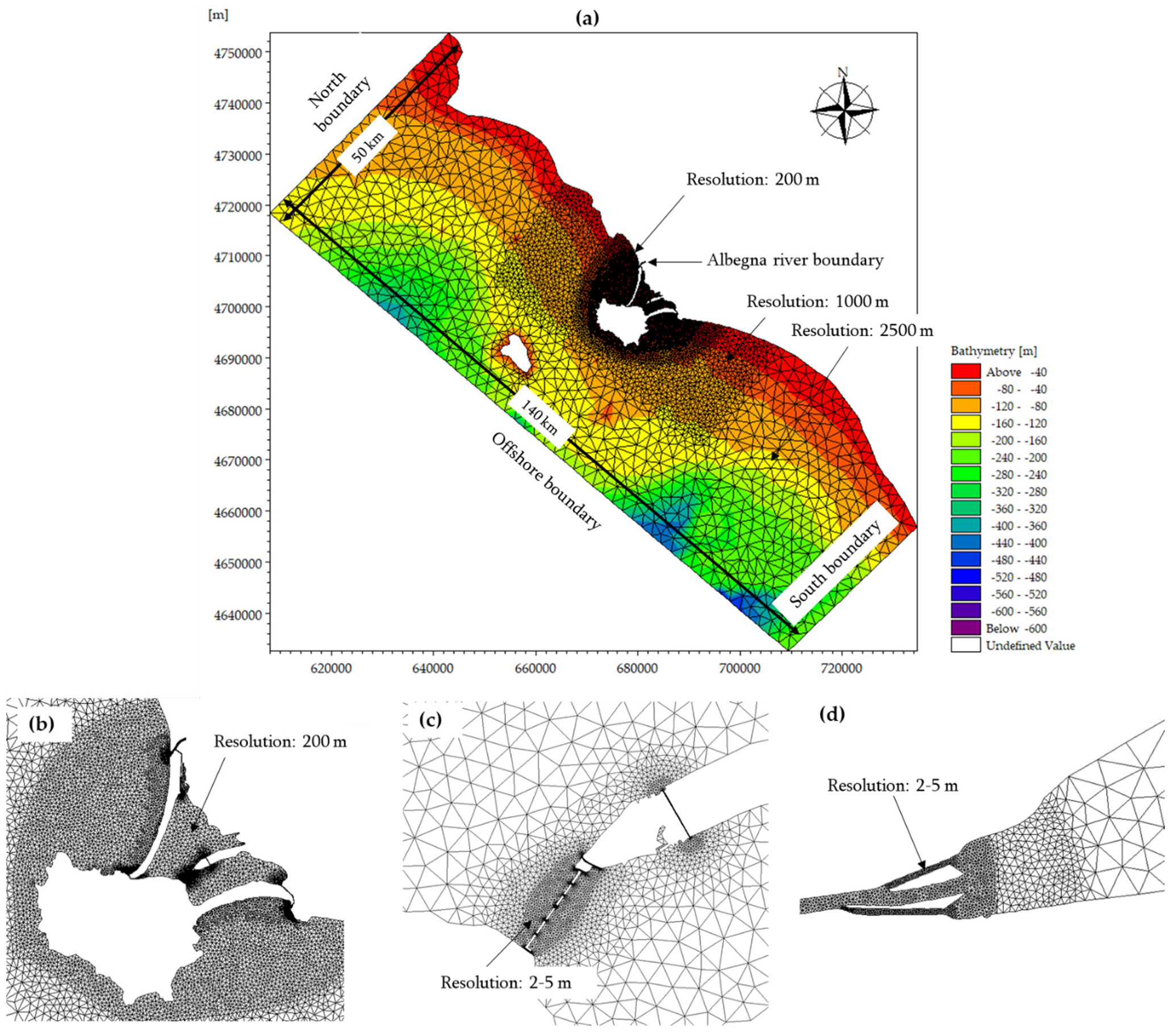
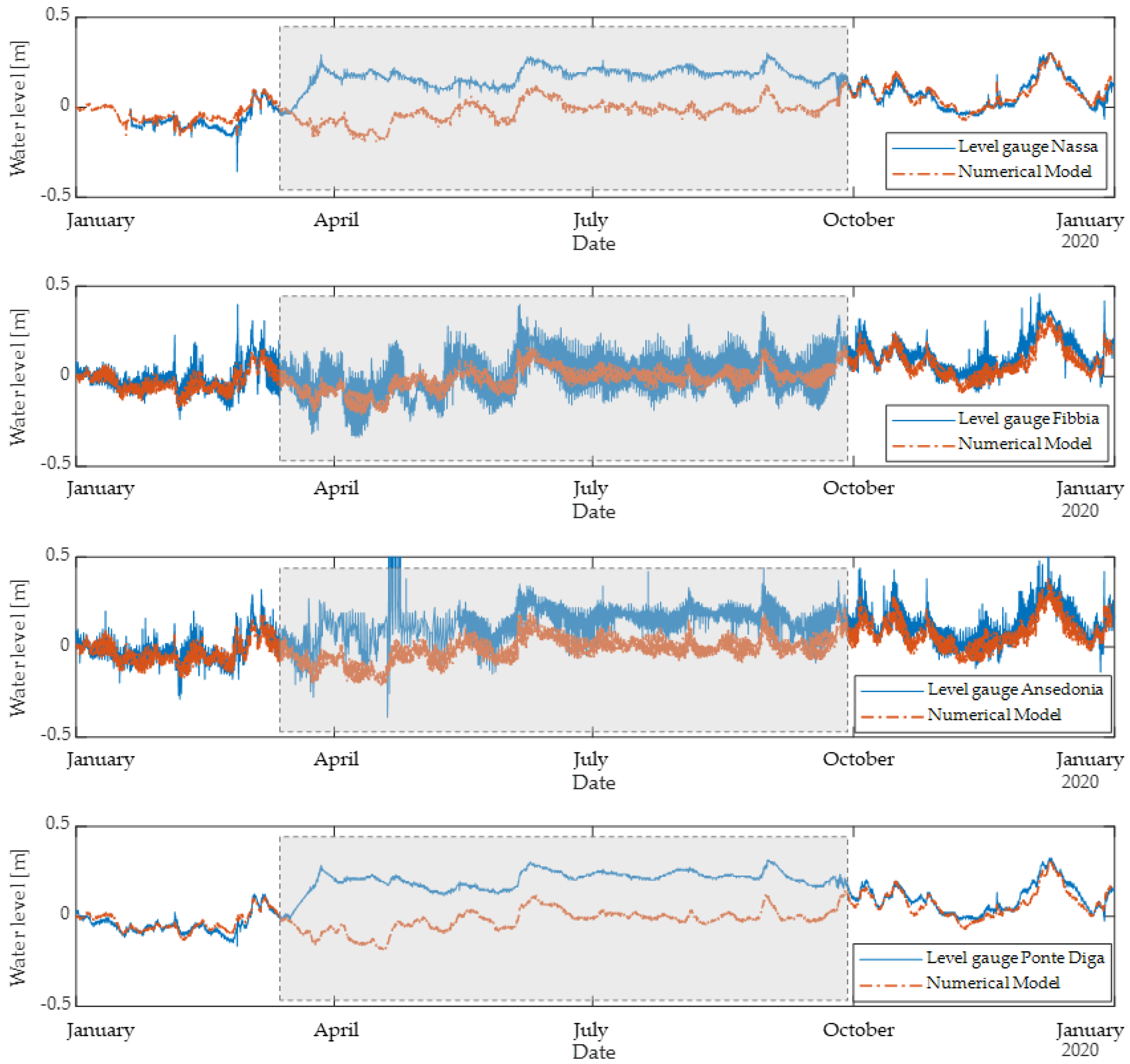
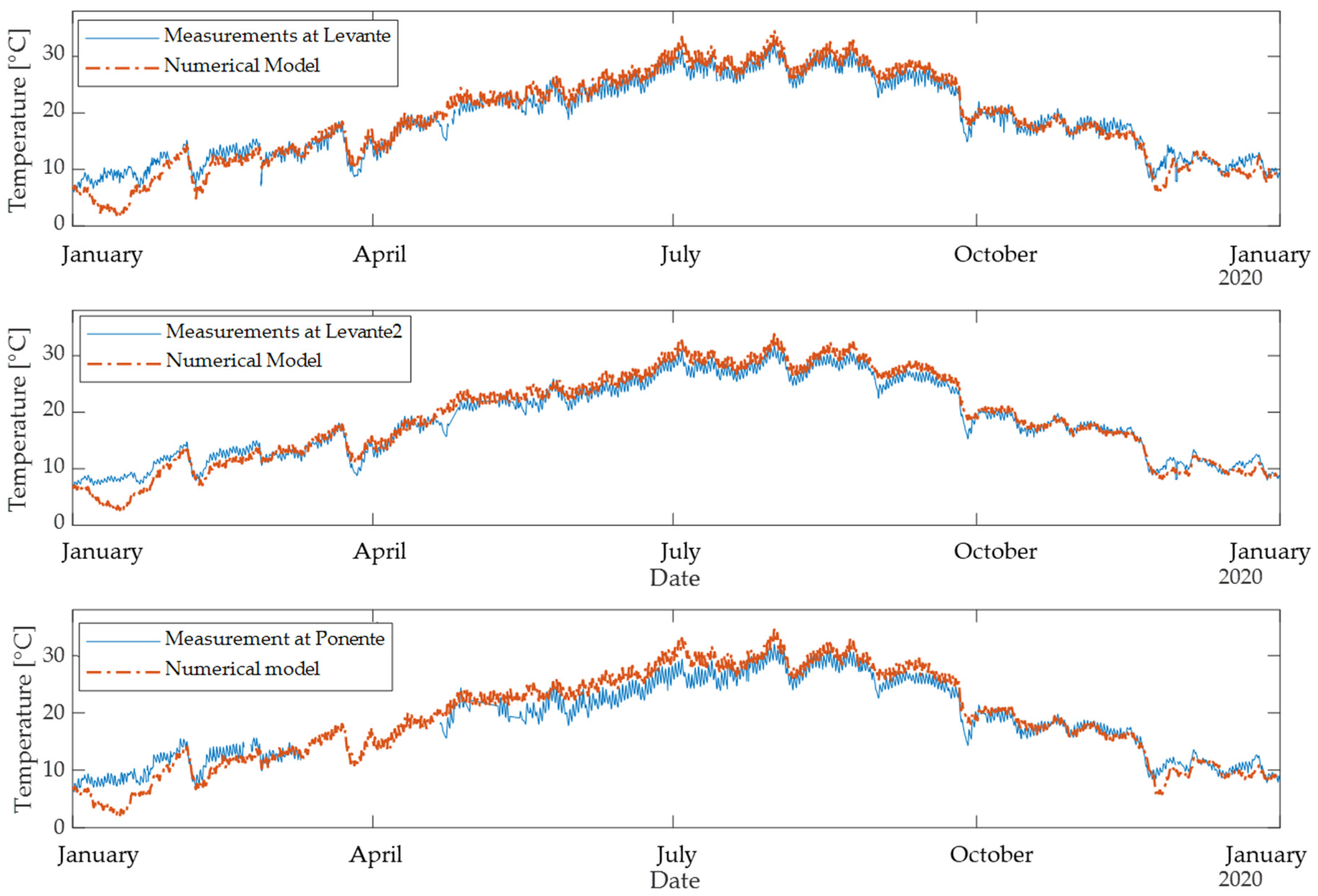

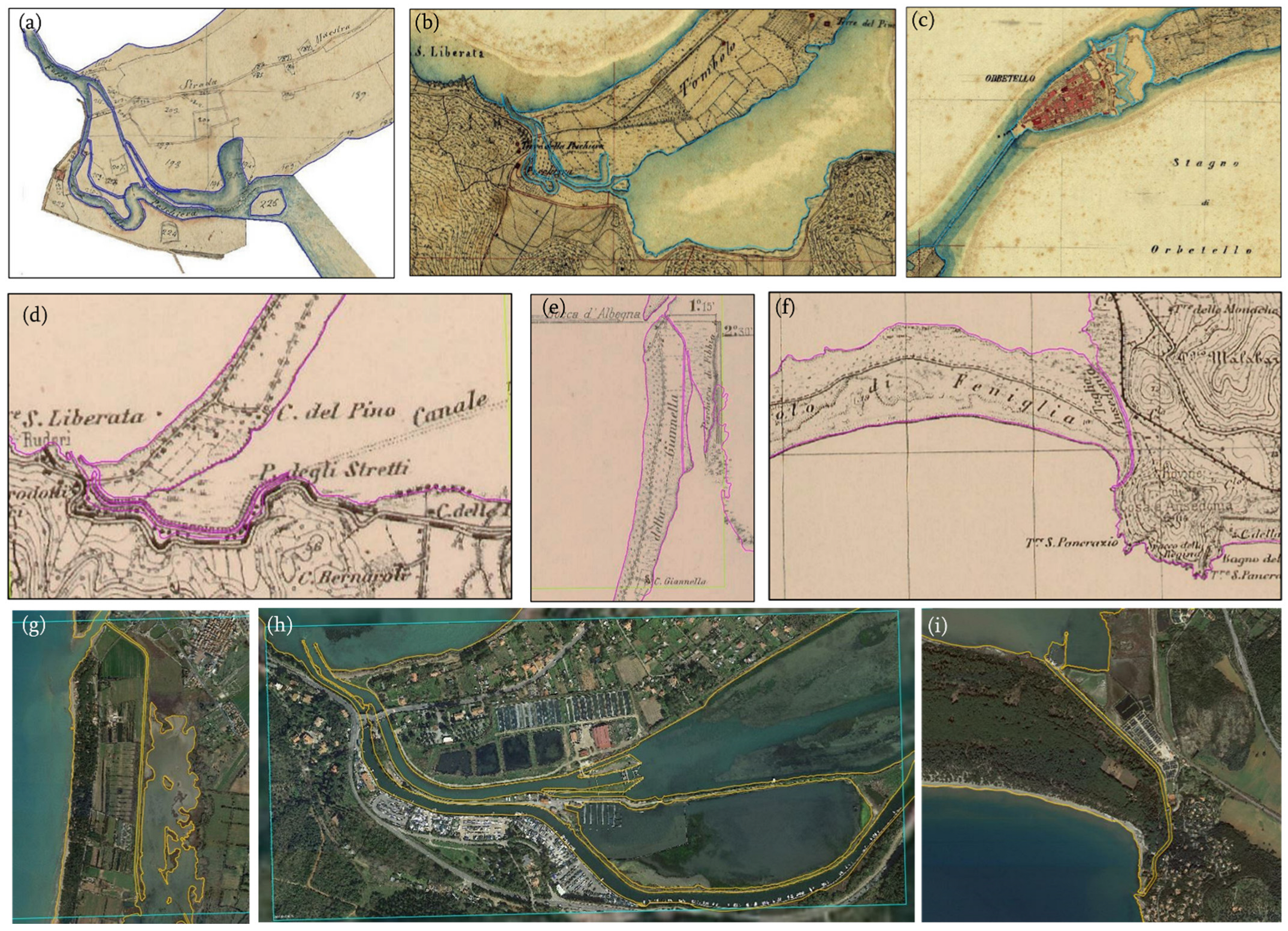

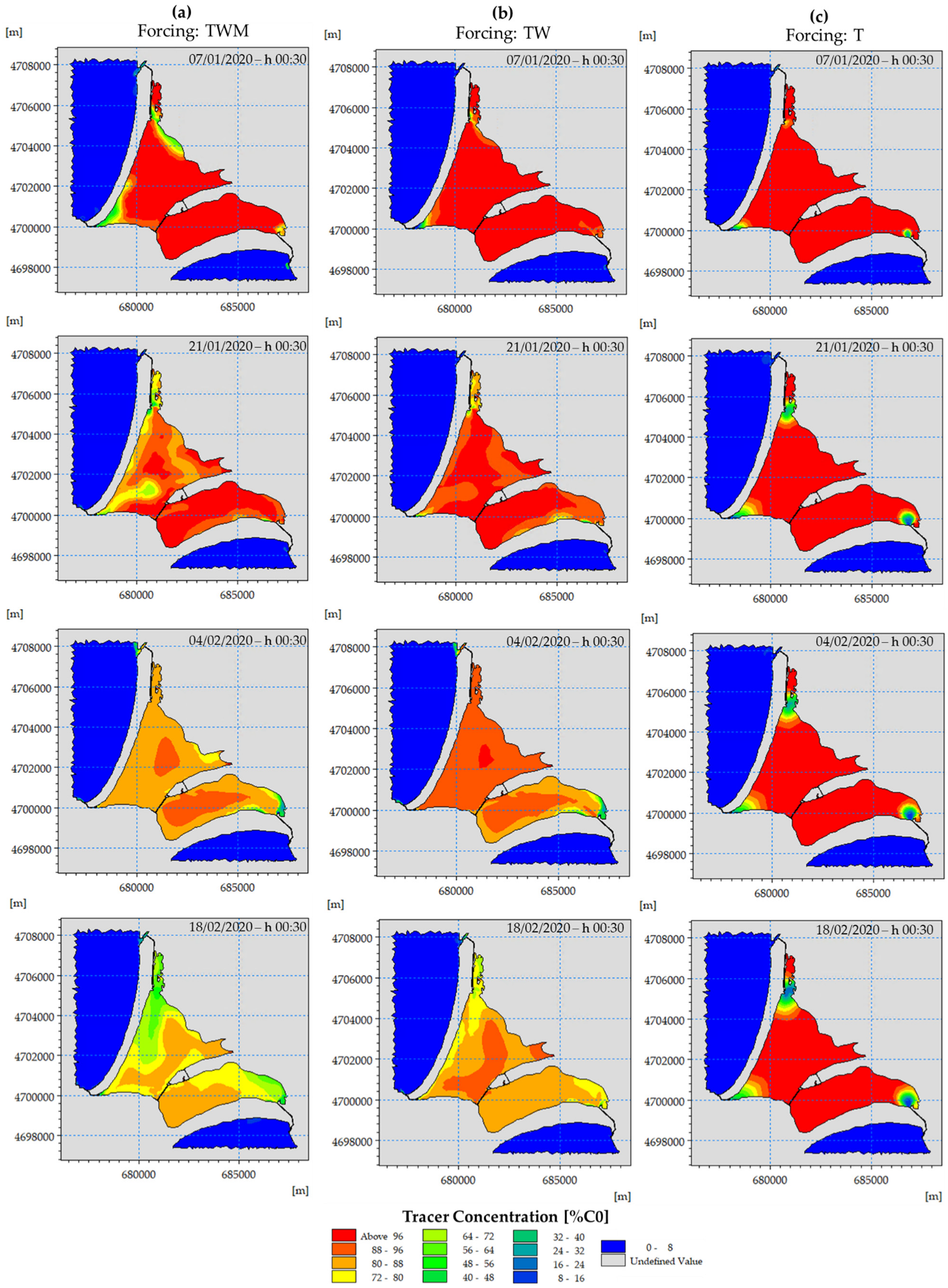
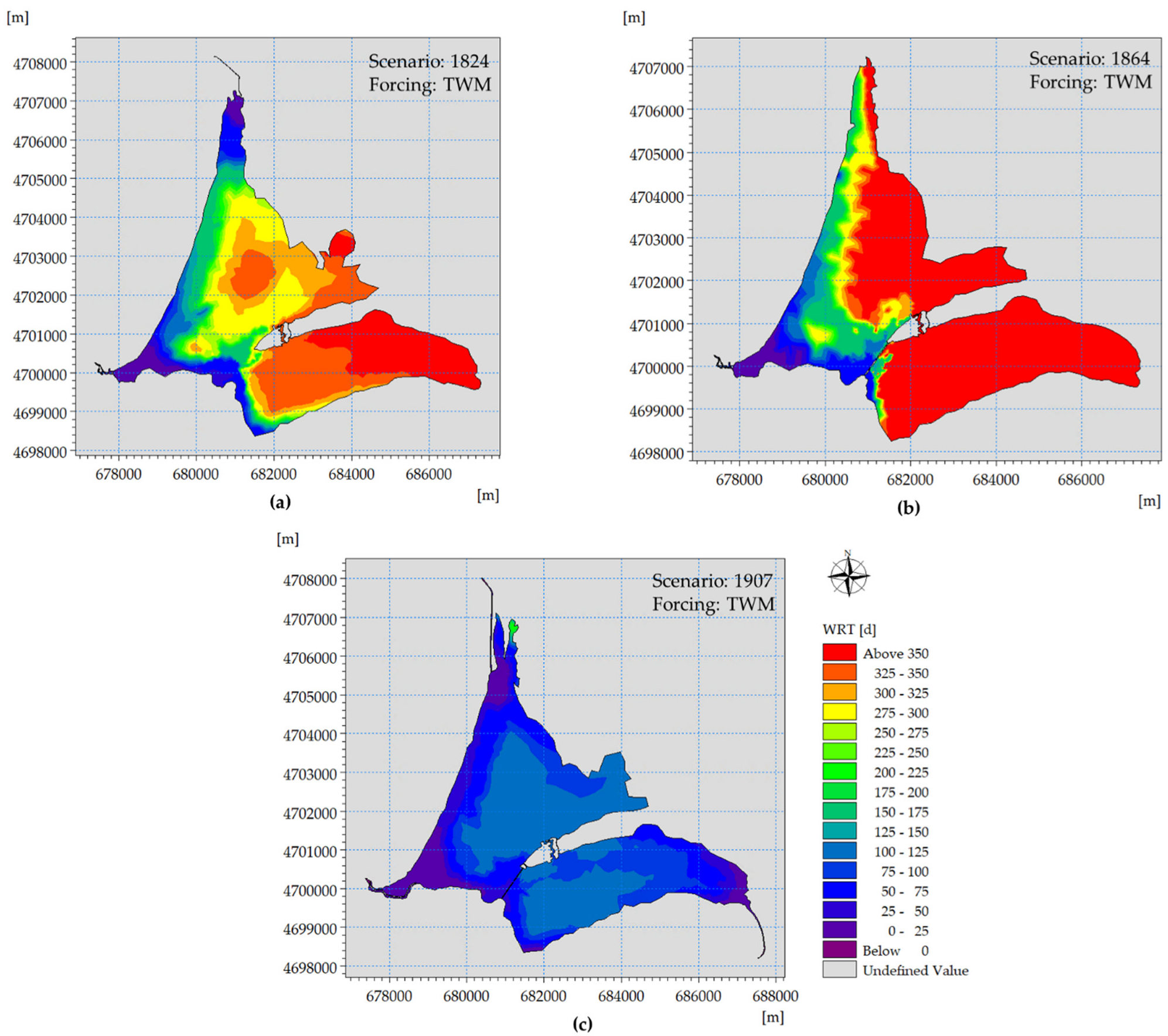
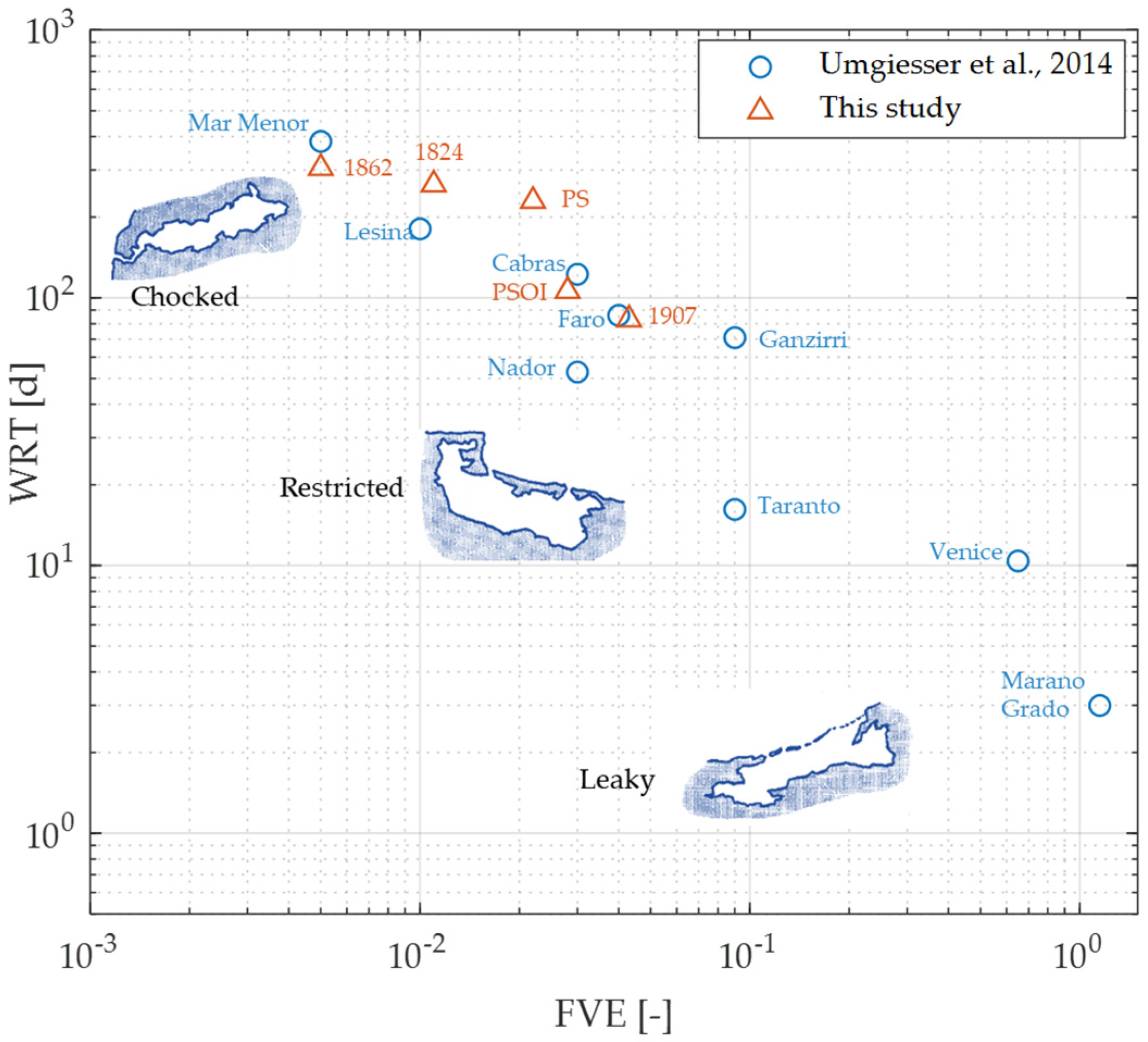
| Monitoring Station | ||||
|---|---|---|---|---|
| Nassa | Fibbia | Ansedonia | Ponte Diga | |
| Water Level—RMSE (m) | 0.029 | 0.043 | 0.039 | 0.024 |
| Water Level—R | 0.96 | 0.93 | 0.93 | 0.96 |
| Monitoring Station | |||
|---|---|---|---|
| Levante | Levante2 | Ponente | |
| Temperature—RMSE (°C) | 1.52 | 1.25 | 1.19 |
| Temperature—R | 0.93 | 0.96 | 0.97 |
| Salinity—RMSE (PSU) | 4.11 | 4.24 | 3.19 |
| Salinity—R | 0.83 | 0.78 | 0.81 |
| Scenario | PS | PSOI | ||
|---|---|---|---|---|
| Index/Forcings | TWM | TWM | TW | T |
| Average water inflow * through Nassa inlet (m3/s) | 4.8 | 4.7 | 4.7 | 4.6 |
| Average water inflow * through Fibbia inlet (m3/s) | 1.8 | 2.3 | 2.3 | 2.3 |
| Average water inflow * through Ansedonia inlet (m3/s) | 0.7 | 2.5 | 2.2 | 2.2 |
| Total average water inflow * through the inlets (m3/s) | 7.3 | 9.4 | 9.2 | 9.1 |
| Average daily volume entering the lagoon (m3/day) | 633,666 | 814,173 | 795,156 | 784,901 |
| Fraction of the volume exchanged daily with the sea, FVE (-) | 0.022 | 0.028 | 0.027 | 0.027 |
| Water flushing time, WFT (days) | 46 | 36 | 37 | 37 |
| Water residence time, WRT (days) | 230 | 106 | 224 | >780 |
| Mixing efficiency, ME (-) | 0.20 | 0.34 | 0.16 | <0.05 |
| Forcing: TWM | ||||
|---|---|---|---|---|
| Index/Scenario | 1824 | 1862 | 1907 | PS |
| Average water inflow * through Nassa and S. Liberata inlets ** (m3/s) | 3.2 | 1.8 | 8.5 | 4.8 |
| Average water inflow * through Fibbia inlet (m3/s) | 0.7 | 0.0 | 2.5 | 1.8 |
| Average water inflow * through Ansedonia inlet (m3/s) | 0.0 | 0.0 | 3.7 | 0.7 |
| Total average water inflow * through the inlets (m3/s) | 3.9 | 1.8 | 14.7 | 7.3 |
| Average daily volume entering the lagoon (m3/day) | 334,221 | 159,373 | 1,270,011 | 633,666 |
| Fraction of total volume exchanged daily with the sea, FVE (-) | 0.011 | 0.005 | 0.043 | 0.022 |
| Water flushing time, WFT (days) | 88 | 184 | 23 | 46 |
| Water residence time, WRT (days) | 265 | 305 | 83 | 230 |
| Mixing efficiency, ME (-) | 0.33 | 0.60 | 0.28 | 0.20 |
Publisher’s Note: MDPI stays neutral with regard to jurisdictional claims in published maps and institutional affiliations. |
© 2022 by the authors. Licensee MDPI, Basel, Switzerland. This article is an open access article distributed under the terms and conditions of the Creative Commons Attribution (CC BY) license (https://creativecommons.org/licenses/by/4.0/).
Share and Cite
Simonetti, I.; Cappietti, L. Influence of Inlets Morphology and Forcing Mechanisms on Water Exchange between Coastal Basins and the Sea: A Hindcast Study for a Mediterranean Lagoon. J. Mar. Sci. Eng. 2022, 10, 1929. https://doi.org/10.3390/jmse10121929
Simonetti I, Cappietti L. Influence of Inlets Morphology and Forcing Mechanisms on Water Exchange between Coastal Basins and the Sea: A Hindcast Study for a Mediterranean Lagoon. Journal of Marine Science and Engineering. 2022; 10(12):1929. https://doi.org/10.3390/jmse10121929
Chicago/Turabian StyleSimonetti, Irene, and Lorenzo Cappietti. 2022. "Influence of Inlets Morphology and Forcing Mechanisms on Water Exchange between Coastal Basins and the Sea: A Hindcast Study for a Mediterranean Lagoon" Journal of Marine Science and Engineering 10, no. 12: 1929. https://doi.org/10.3390/jmse10121929
APA StyleSimonetti, I., & Cappietti, L. (2022). Influence of Inlets Morphology and Forcing Mechanisms on Water Exchange between Coastal Basins and the Sea: A Hindcast Study for a Mediterranean Lagoon. Journal of Marine Science and Engineering, 10(12), 1929. https://doi.org/10.3390/jmse10121929






